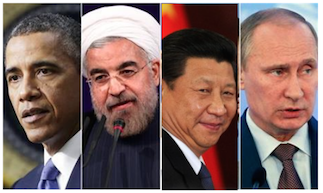By Adil Khan
Central Asia largely evades mainstream media coverage. This is despite it being the centre of a fascinating, ‘great game’ geopolitical contest; fought by the nations of Russia, China, the U.S., and Iran. This is a niche article specifically focusing on Tajikistan, which is vastly underdeveloped, resource rich, and ruled by a corrupt elite. Therefore the collective global powers are pursuing projects ranging from resource exploration to building infrastructure to military funding; economic strategies which may be humanitarianly perceived as efforts to bring security, investment, and development to the region; or cynically viewed as being Machiavellian with an imperialistic agenda. With intertwining debates and deeply interconnected politics, nations are attempting to wield more political power and influence Tajikistan’s future, and subsequently the future of the entire region.
Whose ideology will emerge as the dominant force in Tajikistan? Who will win the power struggle in the latest Central Asian ‘great game’? Tajikistan is amongst the poorest countries in the world, vastly underdeveloped and underexploited in terms of the country’s resources and economic potential. Even conflict-ravaged Afghanistan holds a higher GDP rank. Since gaining independence from the Soviet Union in 1991 Tajikistan has been under the guidance of a despot. President Rahmon, who, according to US embassy cables released by WikiLeaks, has been hoarding large amounts of the country’s wealth in a ‘secretive offshore company’. ‘With the State budget seeing little of this income’, the president has apparently opted to encourage a climate of development by inviting foreign investors to cultivate this region. Given Tajikistan’s development deficiencies and attractive potential, it appears that the country is engaged in an ongoing Central Asian ‘great game’. The collective nations of Iran, Russia, China, and the United States have become the four key players in this geopolitical movement, all competing for influence and control. Pursuing projects ranging from resource exploration to building infrastructure to military development; these ventures may be humanitarianly perceived as efforts to bring security, investment, and development to the region, or perhaps cynically viewed as being Machiavellian with an imperialistic agenda. With intertwining debates and deeply interconnected politics, whose ideology will emerge as the dominant force on the country sometimes known as the Roof of The World?
Iran
Despite the U.S. imposing sanctions on its competitor Iran and encouraging Central Asian nations to sever ties with the Islamic Republic, these requests have been largely rebuffed by Tajikistan. Why then would it discard this advice from one of the world’s premier powers? The answer lies in history. Iran and Tajikistan are deeply bonded through ‘strong cultural and linguistic ties’. This special relationship also extends to realms of art and language, for which Iran provides exhibitions and classes, respectively; thereby consolidating the feeling of solidarity between these two nations and their peoples. More powerful than mere sentimentality however, are the vast economic benefits arising from this cross-cultural engagement. There are over 150 Iranian companies operating and investing in Tajikistan. Iran also provided engineers to design and construct the Sangtoudeh-II power plant, as well as contributing $180 billion towards this project; an asset that is invaluable for the development of Tajikistan and will greatly increase its power output. Iran’s foreign policy of encouraging mutual cooperation has also been heavily influenced by its own internally dire water quagmire.
Over the past 40 years the country has been plagued by droughts and decreasing rainfall levels; with the overuse of subsurface caches and further industrial development only exacerbating the situation. Agriculture may also suffer due to future government plans aiming to reduce water consumption in the sector from 92% to 87%. An agreement signed in 2007 was therefore intended to supply water to Iran by 2013; however this ambitious solution is still yet to be realised. Dialogue between representatives is ongoing; with the most recent proposals suggesting that a hydroelectric power plant is to be built in Tajikistan; along with a 373 mile-long pipeline linking the two nations. Water will then be imported to Iran after it passes through the plant. Alternatively, Tehran has explored the possibility of transporting it via rail; with Iranian oil being used to entice Dushanbe into contemplating a potential trade agreement. Iran and Tajikistan’s special relationship has been allowed to blossom over a period of 2500 years, suggesting that it will likely survive the current geopolitical circus surrounding the region. Should instabilities arise, Tehran has hitherto equipped Dushanbe with military hardware. In 2011 Iran’s Minister of Defence even offered to provide swift military assistance should Tajikistan’s security be compromised. Far from just playing the ‘Big Brother’ type protective role however, this rhetoric was apparently designed to irk Russia. So what of Tajikistan’s former Communist master?
Russia
Russia’s primary concern with Tajikistan is the 1,344 km border it shares with Afghanistan; apparently fearing that Islamic militancy will leak across towards Russia’s frontiers. It is therefore attempting to consolidate the security of the region through the modernisation of the Tajik military, by providing them with training and equipment. In return, approximately 7,000 Russian troops are stationed within the country at Base 201; a military garrison leased out to the Russians rent-free until 2042, after an agreement was signed by the Russian and Tajik defence ministers in 2012.
- Since gaining independence from the Soviet Union in 1991 Tajikistan has been under the guidance of a despot
- Iran, Russia, China, and the United States have become the four key players in this geopolitical movement, all competing for influence and control
- There are over 150 Iranian companies operating and investing in Tajikistan
- approximately 7,000 Russian troops are stationed in Tajikistan
- Currently, Russia’s regional investment is in decline; creating an apparent vacuum which is ironically being embraced by yet another ‘great game’ player, China
- Remittances sent by Tajik migrant workers have been in sharp decline; which has subsequently had a negative effect on development in Tajikistan
- With Russia’s economic growth being stymied by the sanctions to an extent, and given the rising Chinese influence and greater competition for resources, there is potential for rapid escalation in hostilities
- Beijing has key energy interests; currently construction of a gas pipeline is underway in order to feed China’s demand
- Since 2001 the U.S. has spent close to $200 million on the training of Tajik military units
This Russian presence is essential; not only to prevent the spread of militancy from Afghanistan as foreign forces withdraw, but also to avert Tajikistan from potentially relapsing into civil war, or indeed a regional war with its threatening neighbours, Uzbekistan. Economist Farrukh Akhmedov notes that currently Tajik forces are unequipped to manage a possible conflict, and would be reliant upon Russian forces to defend the Republic should hostilities transpire. However, there are some analysts in the West who are sceptical of this foreign policy and view Russia’s manoeuvres as having an imperialistic vibe. Indeed, Russia’s role as guardian may be more than solely a humanitarian gesture to protect its compatriots. Its military presence could perhaps be rooted in a deeper, more Machiavellian agenda with an ulterior motive; primarily concerned with security, but ultimately using this as a means to reaffirm influence over its regional neighbour and wield more political power in Dushanbe. This comes at a time when its historically firm political and economic control over this region is seemingly waning. Much like Iran, Russia has been damaged by sanctions imposed by their ‘great game’ rivals, the United States, for its alleged role in the Ukraine crisis. Partially responsible for the downturn in the Russian economy, the sanctions may even cause the country to dive into recession in 2015, according to the economy ministry. Presently speaking however, Russia’s regional investment is in decline; creating an apparent vacuum which is ironically being embraced by yet another ‘great game’ player, China. Tajikistan is also becoming increasingly concerned with improving trade and investment links with Beijing, as according to a report published in September by The European Bank for reconstruction and Development (EBRD), remittances sent by Tajik migrant workers have been in sharp decline; which has subsequently had a negative effect on development in Tajikistan as its own economy relies heavily on these payments. With Russia’s economic growth being stymied by the sanctions to an extent, and given the rising Chinese influence and greater competition for resources, there is potential for rapid escalation in hostilities. Russia also still has key investments to safeguard in Tajikistan, in the form of energy companies and hydro-power stations. Subsequently, whether imperialistic or not, it is in Russia’s interests to protect its energy ventures, and thus the Kremlin’s soldiers are ideally located to repel possible threats. When assessing Russia’s presence in the region, one may conclude that military might and security contingencies are perhaps its most potent assets in Tajikistan.
China
What Russia deems as its strategic ‘backyard’, is now seemingly morphing into President Xi Jinping’s ‘new silk road’. China, recognising the pivotal role Central Asia can play in its economic expansion, has led an investment onslaught. According to the Financial Times, in Tajikistan alone, China was considering investing $6 billion over the coming years. Beijing has key energy interests; currently construction of a gas pipeline is underway in order to feed China’s demand. The pipeline will merely transit through Tajikistan however; Dushanbe’s involvement in the project is based more upon the millions of dollars it will receive through commission. President Xi Jinping has described the venture as a ‘symbol of China-Tajikistan friendship’, while President Rahmon has aims of transforming Tajikistan into a major oil and gas exporter; with Chinese companies at the helm of some of these prospective energy operations. Beijing may also have plans to transcend beyond Tajikistan. Analysts are speculating that perhaps China is contemplating investing in ‘Rogun’: a hydroelectric dam with the potential to power vast swaths of Central Asia, and in particular South Asia; where Beijing envisions great economic opportunities. It appears that China’s foresight also extends towards infrastructure. There are reports suggesting the creation of a new Tajik rail line, partly funded by the Export-Import Bank of China; and with the possible option of eventually extending this link to China. Moreover, a road project, creating transport connections between Tajikistan and its neighbour Kyrgyzstan has also been undertaken by Chinese companies. The numerous infrastructural developments are apparently part of a wider scheme by China. According to Businessweek, logistically they will provide greater opportunities to explore the region’s abundant resources, as well as allow the Chinese to build relations with European economic markets. And from a strategic standpoint, the infrastructure may also consolidate the China-Central Asian connection; as Beijing considers the region as its partner as it partakes in an internal struggle against separatist insurgents in western China. It appears however, that militarily, China is not merely concerned with its domestic policies. In this geopolitical contest, it has on occasions allied with Russia as part of the Shanghai Cooperation Organisation (SCO). Running military drills together along with the Central Asian States, including Tajikistan; China and Russia have reinforced their ‘regional hegemony’ whilst simultaneously attempting to challenge Washington’s global authority. Equally, Beijing and Moscow could also be termed as rivals. Russian arms dealings with China are extensive, however Moscow is not inclined to part with its most advanced weaponry ‘for fear that China’s military could become too strong’. On the other hand, China’s Defence Minister has also seemingly pledged ‘hundreds of millions of Dollars’ to Tajikistan in military aid; an area of interest which has been traditionally dealt with by Russia.
The United States
The effects of U.S. sanctions against Russia have to an extent, rippled across to negatively impact upon the economies of Central Asian nations including Tajikistan. Incidentally, these sanctions could be viewed as a great game-esque, Machiavellian manoeuvre designed to weaken a rival and its global influence. Indeed, according to President Putin, the sanctions are part of a larger ‘policy of containment [of Russia] which has…..been held against our country for decades, if not centuries’, and that if the situation in Ukraine had not transpired then ‘any other excuse would have been created’ in order to punish Russia. Interesting to note however, previously in 2009 the U.S. ambassador to Tajikistan denied that America was participating in a ‘great game’. The U.S. does though provide considerable assistance to Dushanbe under the mantra of ‘peace and security’; firstly due to the country’s proximity to Afghanistan, and secondly because of the withdrawal of foreign combat troops which has taken place at the end of December. According to a report by Politico, since 2001 the U.S. has spent close to $200 million on the training of Tajik military units. Since 2003 it has also helped to strengthen border posts and construct logistical infrastructure. Conversely, Dushanbe has been dubbed as one of Washington’s ‘most awkward allies’; perhaps because it is ranked 152 out of 175 on Transparency International’s ‘Corruption Perception Index’. Plus, despite vast sums of aid the drugs trade is still to be effectively curbed; figures suggest that over 80% of Afghanistan’s heroin exports to Europe and Russia first transit through Tajikistan. Further compounding matters, it is claimed that due to the suspected collusion between the major traffickers and government officials, the GKNB (the successor organisation of the KGB), instead pursues the small-scale drug pedlars that have little political weight. A sceptical assessment of U.S. policy may state that because Washington has previously provided training to some members of the GKNB, it is in actuality ‘helping the government of Tajikistan take out its drug-trafficking competition’. In the special report by Politico, a rather sobering conclusion can
be drawn regarding the development of Tajikistan: ‘it is perhaps drug traffickers who have benefited most from tens of millions of dollars in U.S. investment in the country’s infrastructure; the very roads that feed America’s war machine allow smugglers to carry heroin out of Afghanistan’.
Where do Tajikistan’s allegiances lie?
Tajikistan is the poorest piece in the multifaceted jigsaw of Central Asia, being pulled by all corners of the globe. The plot thickens with India and Pakistan also seeking to enter the geopolitical mix. It seems therefore that Tajikistan is diversifying its economic potential. But at what cost to its people, their identity, and even its leadership? With the political elite apparently drowning in ‘cronyism and corruption’, if Tajikistan becomes too dependant on its foreign partners, it could perhaps lose its ability to function as an independent State, and ultimately, its sovereignty.











